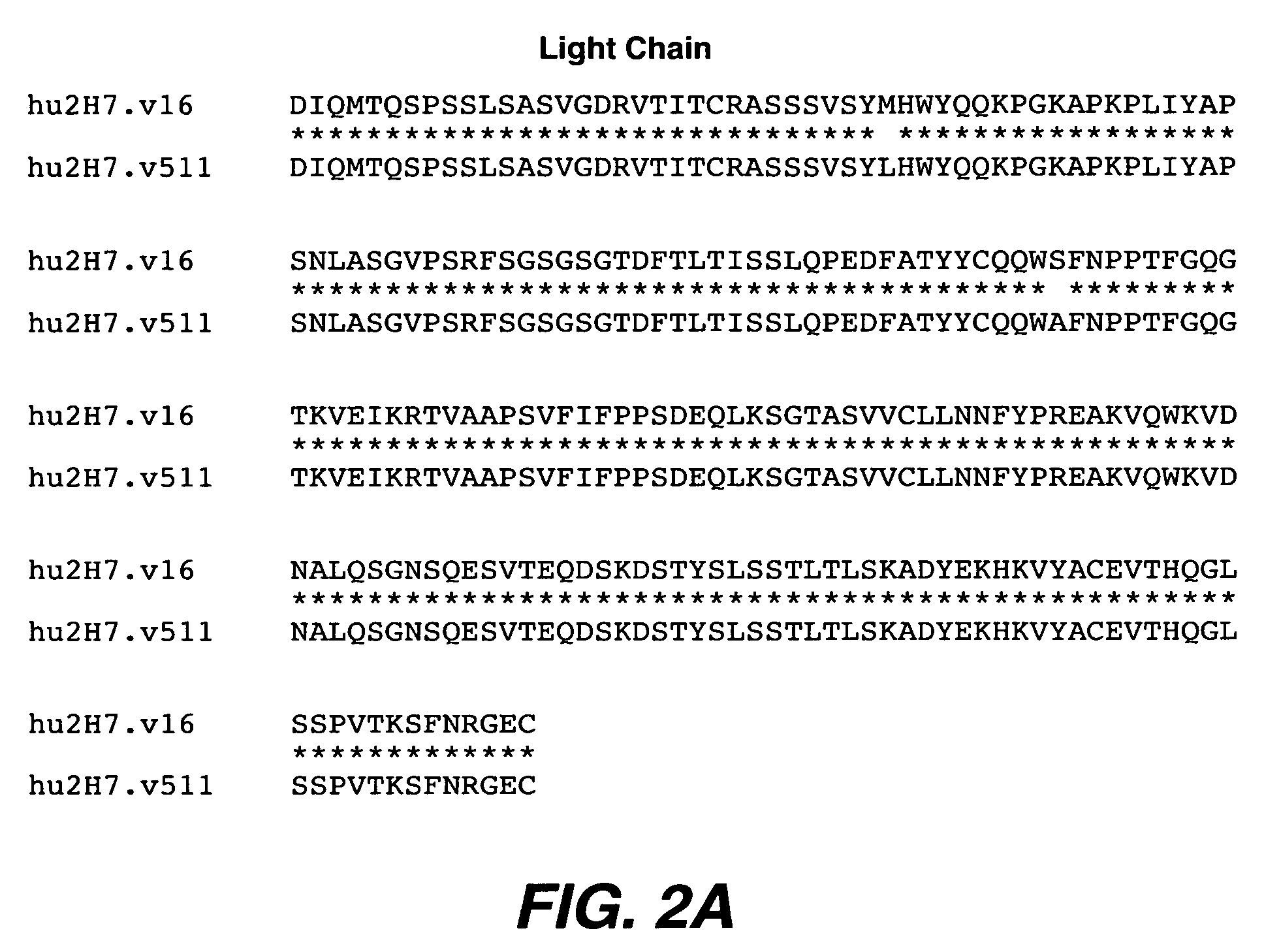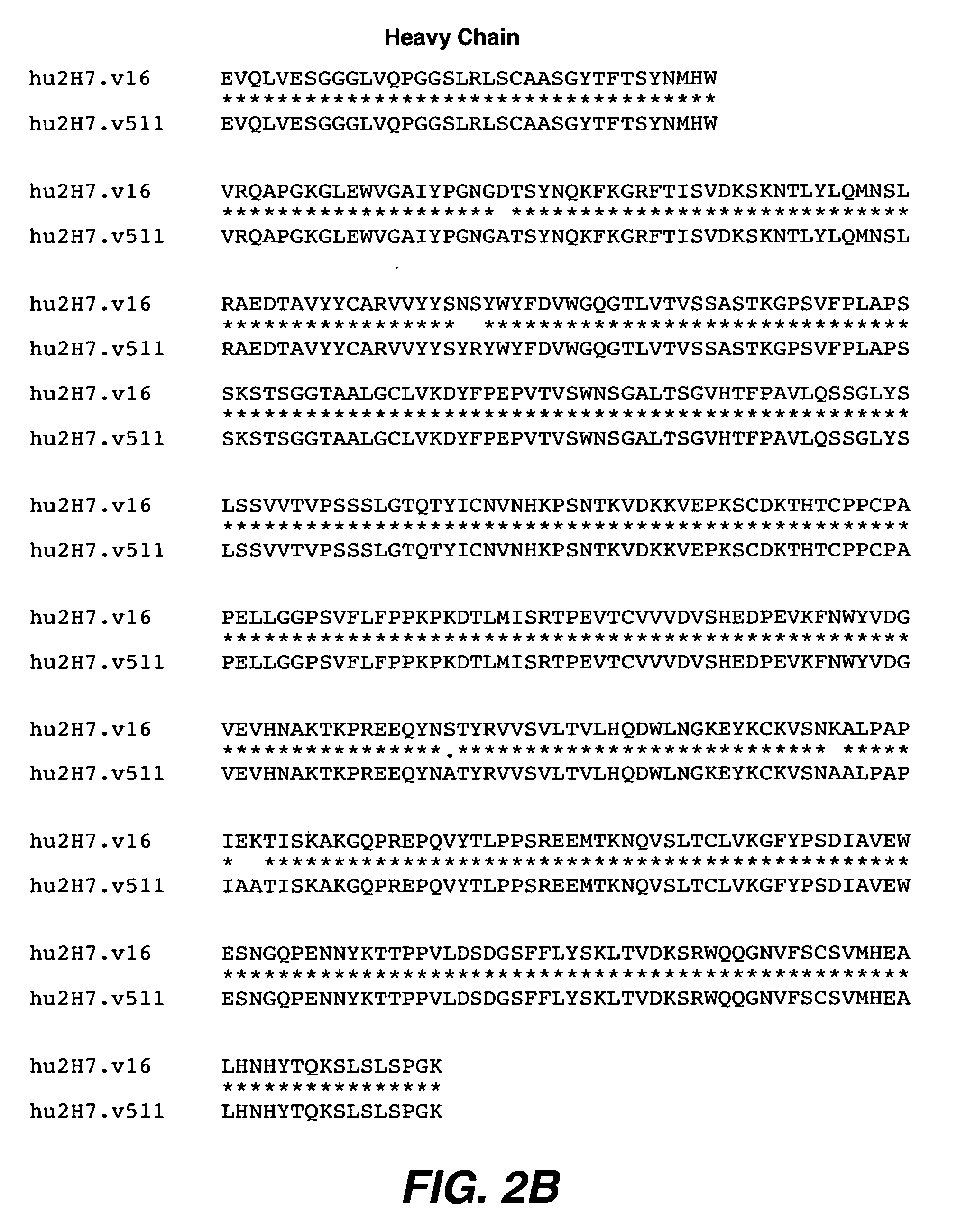Antibody variants and uses thereof
a technology of anti-mouse antibodies and variants, which is applied in the field of anti-mouse antibodies and their use, can solve the problem of human anti-mouse antibody response limit in the use of murine antibodies in human therapy, and achieve the effects of improving adcc and/or cdc effector functions, improving adcc and/or cdc activity, and facilitating antibody-dependent cellular cytotoxicity
- Summary
- Abstract
- Description
- Claims
- Application Information
AI Technical Summary
Benefits of technology
Problems solved by technology
Method used
Image
Examples
experimental examples
Materials
[0291] Mice: Generation of human CD20 (hCD20)+ mice was accomplished through the use of bacterial artificial chromosomes (BAC) incorporating the hCD20 locus. Positive BAC clones were injected into blastocytes derived from FVB mice to generate transgenic (Tg) founder lines that expressed hCD20. See detailed description of generation and characterization of hCD20 Tg+ mice in Gong et al. (2005) J. Immunol. 174:817-826. HCD20Tg+ mice were subsequently bred with hCD16Tg+ mCD16− / − to generate hCD20Tg+ mCD16− / −hCD16Tg+ mice, which were used in the studies described below.
Antibodies: all antibodies used in FACS analysis were purchased from BD PharMingen.
Equipments / software: FACS analysis was performed using FACScan or FACSCalibur machines, and using CellQuest software purchased from Becton Dickinson.
General Methods
[0292] Preparation of single cell suspensions: 50 μl of mouse blood was collected orbitally using EDTA-containing tubes, followed by a red cell lysis using ACK L...
example 1
Humanization of 2H7 Anti-CD20 Murine Monoclonal Antibody
[0295] Humanization of the murine anti-human CD20 antibody, 2H7 (also referred to herein as m2H7, m for murine), was carried out in a series of site-directed mutagenesis steps. The murine 2H7 antibody variable region sequences and the chimeric 2H7 with the mouse V and human C have been described, see, e.g., U.S. Pat. Nos. 5,846,818 and 6,204,023. The CDR residues of 2H7 were identified by comparing the amino acid sequence of the murine 2H7 variable domains (disclosed in U.S. Pat. No. 5,846,818) with the sequences of known antibodies (Kabat et al., Sequences of proteins of immunological interest, Ed. 5. Public Health Service, National Institutes of Health, Bethesda, Md. (1991)). The CDR regions for the light and heavy chains were defined based on sequence hypervariability (Kabat et al., supra) and are shown in FIG. 1A and FIG. 1B, respectively. Using synthetic oligonucleotides (Table 1), site-directed mutagenesis (Kunkel, Proc....
example 2
Additional Mutations within 2H7CDR Regions
[0308] Substitutions of additional residues and combinations of substitutions at CDR positions that were identified as important by Ala-scanning were also tested. Several combination variants, particularly v.96 appeared to bind more tightly than v.16.
TABLE 6Effects of combinations of mutations and non-alaninesubstitutions in the CDR regions of humanized 2H7.v16 measuredusing cell-based ELISA (WIL2-S cells). The relative binding toCD20 is expressed as the concentration of the 2H7.v16 parentover the concentration of the variant required for equivalent binding;hence a ratio ratio > 1 indicates higher affinity for the variant. Standarddeviation in relative affinity determination averaged + / −10%.Framework substitutions in the variable domains are relative to 2H7.v16according to the numbering system of Kabat (Kabat et al., supra).2H7Heavy chainLight chainRelativeVersionsubstitutionssubstitutionsbinding16——-1-96D56A, N100AS92A3.597S99T, N100G, Y...
PUM
| Property | Measurement | Unit |
|---|---|---|
| pH | aaaaa | aaaaa |
| pH | aaaaa | aaaaa |
| pH | aaaaa | aaaaa |
Abstract
Description
Claims
Application Information
 Login to View More
Login to View More - R&D
- Intellectual Property
- Life Sciences
- Materials
- Tech Scout
- Unparalleled Data Quality
- Higher Quality Content
- 60% Fewer Hallucinations
Browse by: Latest US Patents, China's latest patents, Technical Efficacy Thesaurus, Application Domain, Technology Topic, Popular Technical Reports.
© 2025 PatSnap. All rights reserved.Legal|Privacy policy|Modern Slavery Act Transparency Statement|Sitemap|About US| Contact US: help@patsnap.com



